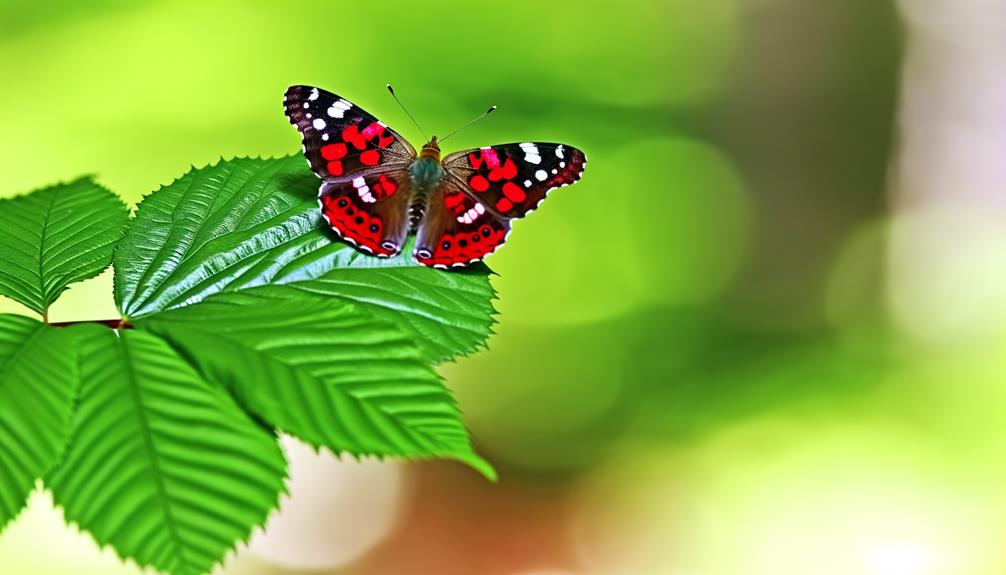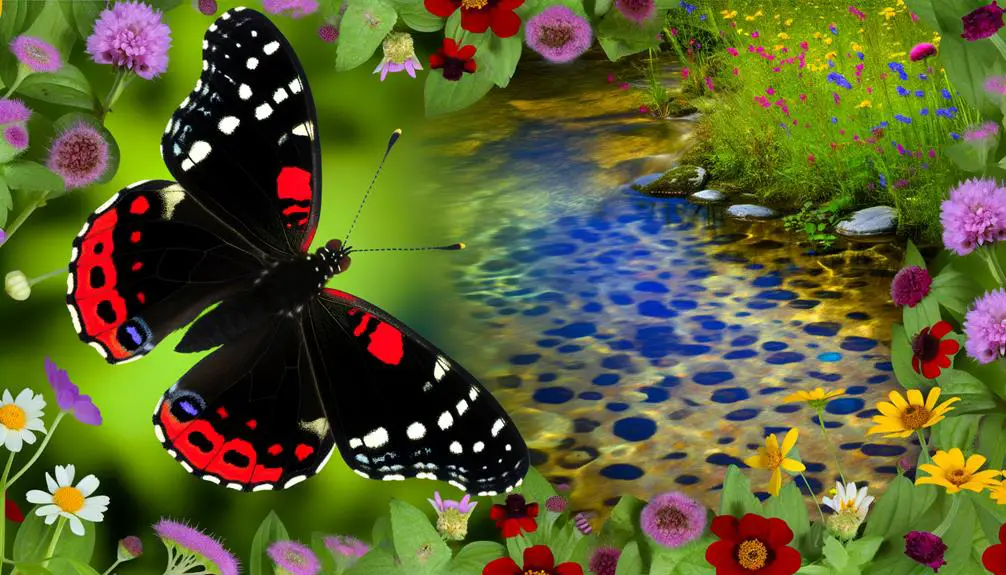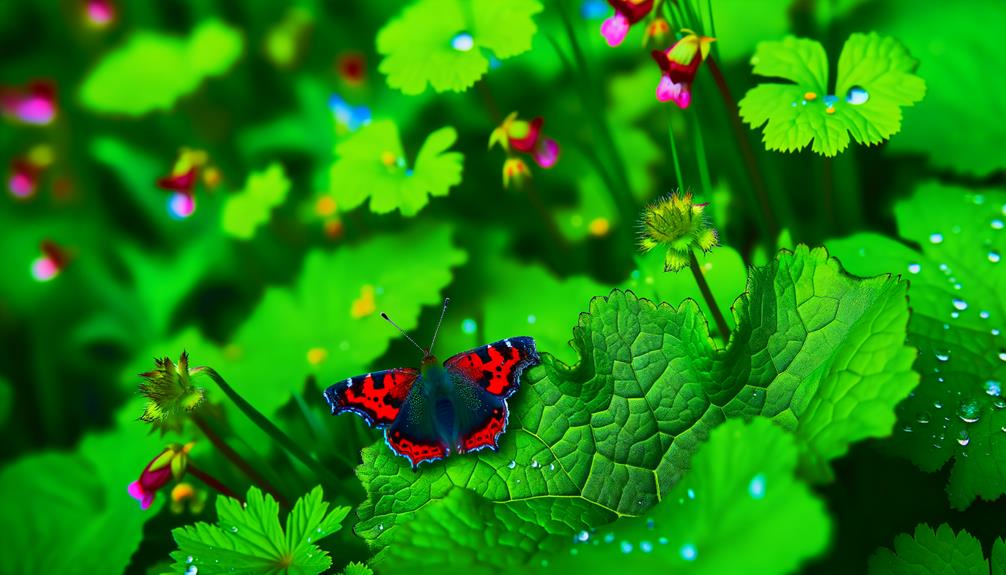Identifying Red Spotted Admiral Butterfly Facts: Key Features and Characteristics
The Red Spotted Admiral butterfly (Limenitis arthemis) is distinguished by its black wings with striking red-orange spots and blue marginal bands, boasting a wingspan of 45 to 65 millimeters. It undergoes complete metamorphosis, including egg, larva, pupa, and adult stages, with eggs laid individually on host plants like black cherry.
This species inhabits deciduous woodlands from the eastern United States to southern Canada, favoring forest edges. Adults feed primarily on nectar, while larvae consume host plant leaves, playing essential roles in pollination and the food web.
For further insights into its habitat preferences and migratory habits, explore our detailed sections.

Key Takeaways
- The Red Spotted Admiral butterfly has black wings with red-orange spots and blue markings.
- It undergoes complete metamorphosis, including egg, larva, pupa, and adult stages.
- This butterfly inhabits deciduous and mixed woodlands, ranging from eastern U.S. to southern Canada.
- It primarily feeds on nectar but also consumes fruit, tree sap, and animal droppings.
Unique Physical Characteristics

The Red Spotted Admiral Butterfly exhibits unique physical characteristics, most notably its striking black wings adorned with red-orange spots and blue markings along the edges. This distinctive coloration serves as a visual warning to potential predators, signaling that the butterfly may be toxic or unpalatable.
The wingspan ranges from 45 to 65 millimeters, making it a medium-sized butterfly. The forewings are mainly black with a conspicuous pattern of red spots, while the hindwings feature blue marginal bands that enhance its vivid appearance.
The ventral side is more subdued, showcasing brown and gray hues that provide effective camouflage against predators when the butterfly is at rest. These morphological traits are essential for both its survival and mating rituals.
Life Cycle Stages
Red Spotted Admiral Butterflies undergo a complete metamorphosis, progressing through distinct stages of egg, larva, pupa, and adult.
The cycle begins when eggs are laid individually on host plants, typically on the underside of leaves. Upon hatching, the larva, or caterpillar, emerges and begins feeding voraciously on foliage.
The larval stage is characterized by multiple instars, during which the caterpillar molts several times as it grows. Once fully developed, the caterpillar enters the pupal stage, forming a chrysalis where it undergoes significant transformation.
Inside the chrysalis, the organism restructures into its adult form. The adult butterfly then emerges, ready for reproduction, thereby perpetuating the life cycle.
Each stage is critical for the butterfly's development and survival.
Habitat and Range

Understanding the habitat and range of the Red Spotted Admiral Butterfly is vital for comprehending the environmental conditions that support each stage of its life cycle. This butterfly is typically found in deciduous forests, marshes, and meadows, where host plants like willows and poplars thrive. By studying its distribution, researchers can interpret Red Admiral Butterfly meaning in ecological terms, understanding how climate and habitat influence its population dynamics. Conservation efforts focus on preserving these habitats to ensure the species’ continued survival.
This species mainly inhabits deciduous and mixed woodlands, favoring areas with abundant host plants. Geographically, their range extends from the eastern United States through parts of southern Canada.
Preferred habitats include forest edges, riverbanks, and areas with plentiful sunlight. The butterfly's presence in these locations correlates with the availability of host plants such as black cherry and willow, which are essential for larval development.
Seasonal migrations also influence their range, with some populations moving southward during colder months. This distribution underscores the species' adaptability to diverse ecological niches and climatic conditions.
Feeding Habits
Feeding mainly on nectar, the Red Spotted Admiral Butterfly exhibits a preference for flowers of plants such as milkweed, aster, and viburnum, which provide essential nutrients for its sustenance and energy needs.
The butterfly's proboscis, a specialized feeding organ, facilitates efficient nectar extraction from tubular flowers.
Additionally, the Red Spotted Admiral occasionally consumes overripe fruit, tree sap, and even animal droppings, sources rich in sugars and minerals. This dietary flexibility aids in survival during periods when nectar is scarce.
Larvae of the species chiefly feed on leaves of host plants like wild cherry and poplar, obtaining necessary proteins and other nutrients to support their rapid growth and development.
Such diverse feeding habits guarantee the butterfly's adaptability to varying environmental conditions.
Role in the Ecosystem

The Red Spotted Admiral Butterfly plays an essential role in pollination, contributing greatly to the reproductive success of various flowering plants within its habitat. By transferring pollen while feeding on nectar, these butterflies facilitate cross-pollination, which enhances genetic diversity and plant resilience. Additionally, they serve as prey for birds and other predators, thereby integrating into the food web. Understanding their ecological roles helps in biodiversity conservation efforts.
| Interaction Type | Species Involved | Ecological Impact |
|---|---|---|
| Pollination | Flowering Plants | Genetic Diversity |
| Prey | Birds, Insects | Food Source |
| Host Plant Usage | Willow, Poplar Trees | Habitat Maintenance |
| Competitors | Other Pollinators | Resource Competition |
| Decomposers | Soil Microorganisms | Nutrient Recycling |
Their interdependencies highlight their significance in maintaining ecosystem balance.
Conclusion
The red spotted admiral butterfly, with its distinctive physical traits and complex life cycle, exists within a defined habitat and range, exhibiting specific feeding behaviors.
This lepidopteran's role in the ecosystem is both intricate and significant, contributing to biodiversity and ecological balance.
These attributes underscore the importance of understanding and preserving such species.
Consequently, the red spotted admiral serves as a poignant reminder of the delicate interplay within natural systems, meriting continued study and conservation efforts.






